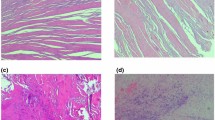Abstract
The tendon ruptures are serious injuries of the lover limb in middle age and physically active population. While the Achilles tendon rupture is common, the patellar ligament and quadriceps ligament ruptures are an absolutely rare injury. Usually there is no correlation between the velocity of the trauma and the supervening of the rupture. The aetiology of the degenerative changes in the collagen structures of the tendons and ligaments which could be disposed for the rupture are still not clear. Our hypothesis was that before the injury there are clear pathological abnormalities in the tissues of the tendons, which are predisposed for the rupture, and could be monitored besides the classical histological methods by differential scanning calorimetry. The thermal denaturation of human samples was monitored by a SETARAM Micro DSC-II calorimeter. All the experiments were performed between 0 and 100 °C. The heating rate was 0.3 K/min. DSC scans clearly demonstrated significant differences between the control and ruptured samples (control: T m = 59.7 °C, T 1/2 = 1.4 °C and ΔH cal = 8.54 J/g; ruptured Achilles tendon: T m = 62.75 °C, T 1/2 = 2.6 °C and ΔH cal = 1.54 J/g, ruptured Quadriceps tendon: T m = 64.8 °C, T 1/2 = 1.6 °C and ΔH cal = 1.53 J/g, ruptured Patellar tendon: T m = 63.9 °C, T 1/2 = 1.41 °C and ΔH cal = 0.97 J/g). These observations could be explained with the structural alterations caused by the biochemical processes. With our investigations we could demonstrate that DSC is a useful and well applicable method for the investigation of collagen tissue of the degenerated human tendons and ligaments. We can prove with this method that the degenerative changes of the tissue elements increase the thermal stability of collagen tissues of the tendons which could be disposed for the rupture.








Similar content being viewed by others
References
Amlang MH, Zwipp H. Damage to large tendons: Achilles, patellar and quadriceps tendons. Chirurg. 2006;77(7):637–49.
Selvanetti A, Puddu G. Overuse tendon injuries: basic science and classification. Oper Tech Sports Med. 1997;5:110–7.
Resch H, Breitfuss H. Spontaneous tendon ruptures. Etiology, pathogenesis and therapy. Orthopade. 1995;24(3):209–19.
Clayton RA, Court-Brown CM. The epidemiology of musculoskeletal tendinous and ligamentous injuries. Injury. 2008;39(12):1338–44.
Yepes H, Tang M, Morris SF, Stanish WD. Relationship between hypovascular zones and patterns of ruptures of the quadriceps tendon. J Bone Joint Surg Am. 2008;90(10):2135–41.
Trobisch PD, Bauman M, Weise K, Stuby F, Hak DJ. Histologic analysis of ruptured quadriceps tendons. Knee Surg Sports Traumatol Arthrosc. 2010;18(1):85–8.
Glazerbrook MA, Wright JR Jr, Langman M, Stanish WD, Lee JM. Histological analysis of achilles tendons in an overuse rat model. J Orthop Res. 2008;26:840–6.
Kannus P. Structure of the tendon connective tissue. Scand J Med Sci Sports. 2008;10(6):312–20.
Maffulli N, Barrass V, Ewen SW. Light microscopic histology of achilles tendon ruptures. A comparison with unruptured tendons. Sports Med. 2000;28:857–63.
Järvinen TA, Järvinen TL, Kannus P, Józsa L, Järvinen M. Collagen fibres of the spontaneously ruptured human tendons display decreased thickness and crimp angle. J Orthop Res. 2004;22:1303–9.
Strauss EJ, Ishak C, Jazrawi L, Sherman O, Rosen J. Operative treatment of acute Achilles tendon ruptures: an institutional review of clinical outcomes. Injury. 2007;38(7):832–8.
Miles CA, Burjanadze TV, Bailey AJ. The kinetics of the thermal denaturation of collagen in unrestrained rat tail tendon determined by differential scanning calorimetry. J Mol Biol. 1995;245(4):437–46.
Sohár G, Pallagi E, Szabó-Révész P, Tóth K. New thermogravimetric protocol for the investigation of normal and damaged human hyaline cartilage. J Therm Anal Calorim. 2007;89:853–6.
Wilhelm F, Kovács KA, Vértes Zs, Lőrinczy D. Human uterus in pregnancy, as it can be monitored by DSC (differential scanning calorimetric) examination. A preliminary study. J Therm Anal Calorim. 2007;89:863–5.
Lőrinczy D, Vértes ZS, Könczöl F, Belagyi J. Thermal transition of actin. J Therm Anal Calorim. 2009;95:713–9.
Nedvig K, Ferencz A, Rőth E, Lőrinczy D. DSC examination of intestinal tissue following warm ischemia and reperfusion injury. J Therm Anal Calorim. 2009;95:775–9.
Willett TL, Labow RS, Lee JM. Mechanical overload decreases the thermal stability of collagen in an in vitro tensile overload tendon model. J Orthop Res. 2008;26(12):1605–10.
Willett TL, Labow RS, Lee JM. Thermal stability of collagen in an in vitro tensile overload tendon model. J Bone Joint Soc Br. 2009;91 D II:217–20.
Willett TL, Labow RS, Avery NC, Lee JM. Increased proteolysis of collagen in an in vitro tensile overload tendon model. Ann Biomed Eng. 2007;35(11):1961–72.
Miles CA, Wardale RJ, Birch HL, Bailey AJ. Differential scanning calorimetric studies of superficial digital flexor tendon degeneration in the horse. Equine Vet J. 1994;26:255–61.
Comerford EJ, Tarlton JF, Innes’ JF, Johnson KA, Amis AA, Bailey AJ. Metabolism and composition of the canine anterior cruciate ligament relate to differences in knee joint mechanics and predisposition to ligament rupture. J Orthop Res. 2005;23:61–6.
Comerford EJ, Inness JF, Tarlton JF, Bailey A. Investigation of the composition, turnover, and thermal properties of ruptured cranial cruciate ligaments of dogs. Am J Vet Res. 2004;65(8):1136–41.
Eriksen HA, Pajala A, Leppilahti J, Risteli J. Increased content of type III collagen at the rupture site of human Achilles tendon. J Orthop Res. 2002;20:1352–7.
Acknowledgements
The SETARAM Micro DSC-II was purchased with a grant (CO-272) from the Hungarian Scientific Research Fund (Dénes Lőrinczy).
Author information
Authors and Affiliations
Corresponding author
Rights and permissions
About this article
Cite this article
Wiegand, N., Vámhidy, L. & Lőrinczy, D. Differential scanning calorimetric examination of ruptured lower limb tendons in human. J Therm Anal Calorim 101, 487–492 (2010). https://doi.org/10.1007/s10973-010-0820-y
Published:
Issue Date:
DOI: https://doi.org/10.1007/s10973-010-0820-y




